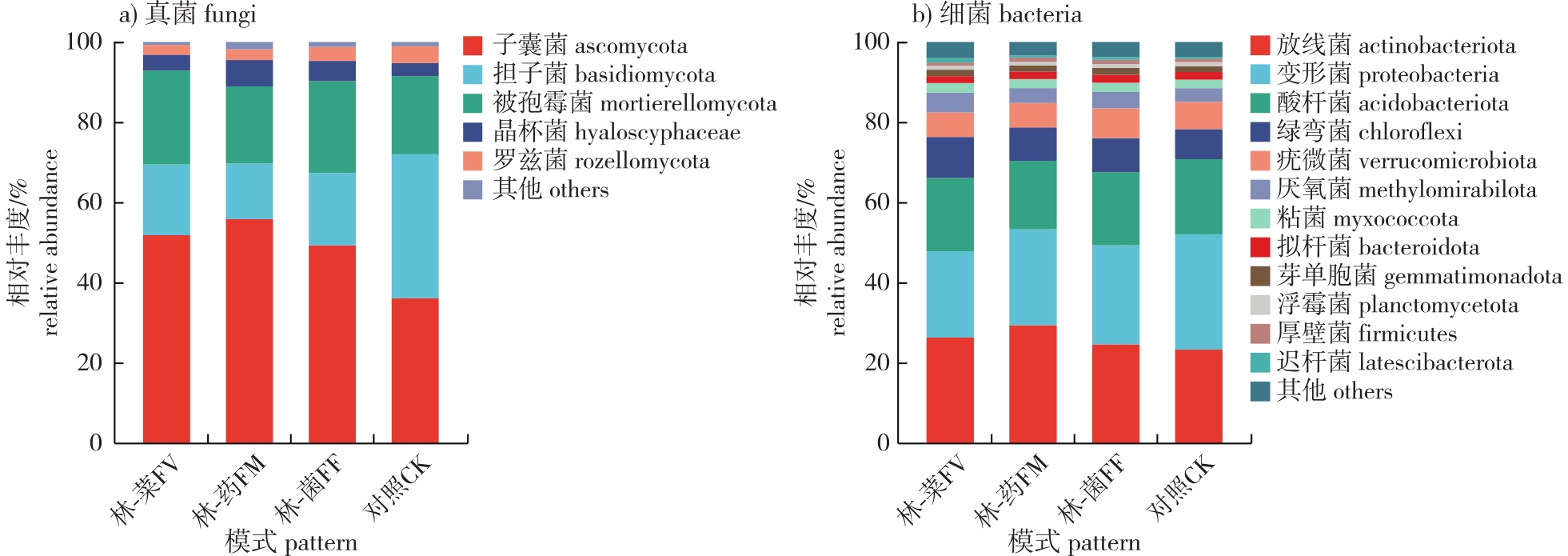 PDF(2440 KB)
PDF(2440 KB)


 PDF(2440 KB)
PDF(2440 KB)
 PDF(2440 KB)
PDF(2440 KB)
红松人工林不同复合经营模式土壤养分、酶活性和微生物特征组成的差异
Variations in soil nutrients, enzyme activities and microbial community composition in different agroforestry patterns of Pinus koraiensis plantation
【目的】筛选合理的红松(Pinus koraiensis)人工林下复合经营模式,为红松人工林复合经营决策提供科学依据。【方法】以不同复合经营模式(林-菌、林-药、林-菜)红松人工林群落为研究对象,以未经补植的样地为对照,调查样方数据、测定并分析复合经营模式红松人工林物种组成、土壤养分水平、酶活性和微生物群落结构等特征。【结果】①经营初期,复合经营模式下群落物种多样性指数比对照低。②林-菌、林-菜经营模式土壤养分积累较高,林-菜、林-药复合经营模式对土壤养分的转化能力较强。③林-菌复合经营模式土壤过氧化氢酶活性最高,其次是林-药复合经营模式,林-菜复合经营模式下则最低;林-药复合经营模式下土壤纤维素酶活性最高,且在(0,10] cm层显著大于(10,20] cm层;不同复合经营模式对土壤蔗糖酶活性和酸性磷酸酶活性无显著影响。④红松人工林不同复合经营模式土壤真菌、细菌群落的丰富度指数与对照样地存在显著差异,多样性指数无显著差异,微生物群落主要由被孢霉菌(mortierellomycota)、子囊菌(ascomycota)、放线菌(actinobacteriota)、变形菌(proteobacteria)等组成,其中子囊菌和放线菌是决定复合经营对微生物养分利用状况影响的主要微生物。⑤Partial Mantel分析表明,细菌和真菌群落最大影响因子是土壤有机碳、全氮含量和人工林植物Simpson指数(P<0.01)。林-菌复合经营模式土壤过氧化氢酶、纤维素酶活性,林-菜复合经营模式土壤有机碳含量、碳氮比,对照样地植物Simpson指数对土壤真菌群落影响显著(P<0.05)。对照样地植物Shannon指数和土壤蔗糖酶活性对细菌群落影响显著(P<0.05)。【结论】复合经营模式会不同程度地影响林下植物群落结构、土壤养分含量和土壤微生物组成。
【Objective】This study aims to identify optimal agroforestry management patterns for Pinus koraiensis plantations and establish a scientific foundation for decision-making in compound management practices.【Method】Three agroforestry systems (forest-fungi, forest-medicine, and forest-vegetable) within P. koraiensis plantations were investigated. Quadrat surveys and high-throughput sequencing were integrated to assess species diversity, soil nutrient dynamics, enzymatic activities, and microbial community structures. Full-length 16S rRNA and ITS amplicon sequencing were utilized to characterize bacterial and fungal communities across soil depths of (0,10] and (10,20] cm.【Result】(1)During initial management stages, species diversity indices in agroforestry systems were lower than those in the control (monoculture plantation).(2)The forest-fungi and forest-vegetable systems exhibited higher soil nutrient accumulation (e.g., organic carbon, total nitrogen), whereas forest-vegetable and forest-medicine systems demonstrated superior nutrient conversion efficiency.(3)Soil catalase activity ranked as forest-fungi > forest-medicine > forest-vegetable, while cellulase activity peaked in the forest-medicine system, with significantly higher values in the (0,10] cm layer than in the (10,20] cm layer (P< 0.05). No significant differences were observed in sucrase or acid phosphatase activities among systems. (4)The α-diversity of soil fungal and bacterial communities was significantly different in richness,and not significantly different in biodiversity,microbial communities across all systems were dominated by mortierellomycota, ascomycota, actinobacteriota, and proteobacteriota, with ascomycota and actinobacteriota identified as key taxa driving nutrient utilization under agroforestry practices. (5)Partial Mantel test revealed than the dominant factors influencing bacterial and fungal communities were soil organic carbon,total nitrogen(TN)and plant Simpson index(P<0.001).In the forest-funus system,both catalase activity and cellulase activity exhibited significant effects on fungal communities,whereas in the forest-vegetable system,soil organic carbon content and C to N ratio,along with the plant Simpson index in control plots,showed notable impacts on fungal communities(P<0.05).Additionally,the plant Shannon index and soil sucrase activity in control plots were indentified as the primary drivers of bacterial community composition(P<0.05).【Conclusion】Agroforestry management initially disrupts understory communities and soil ecosystems, but gradually enhances species richness, nutrient cycling efficiency, and microbial functional stability.

红松人工林 / 复合经营模式 / 植被 / 土壤养分 / 酶活性 / 微生物群落
Pinus koraiensis plantation / agroforestry pattern / vegetation / soil nutrient / enzyme activity / microbial community
| [1] |
崔崧, 肖锐, 王文帆, 等. 小兴安岭针阔混交林碳汇结构特征的研究[J]. 森林工程, 2020, 36(6):30-35.
|
| [2] |
张敏, 朱教君. 光温条件对不同种源红松种子萌发的影响[J]. 植物生态学报, 2022, 46(6):613-623.
|
| [3] |
张玲, 张东来. 红松次生林下不同复合经营模式物种多样性研究[J]. 森林工程, 2021, 37(4):40-46.
|
| [4] |
胡海波, 陈雪, 杨兵. 我国沿海防护林复合经营技术研究进展[J]. 世界林业研究, 2021, 34(4):77-83.
|
| [5] |
|
| [6] |
|
| [7] |
|
| [8] |
|
| [9] |
|
| [10] |
|
| [11] |
|
| [12] |
|
| [13] |
肖良俊, 谢正万, 张传光, 等. 核桃中药材不同复合经营模式土壤肥力综合评价[J]. 东北林业大学学报, 2021, 49(1):91-95.
|
| [14] |
孔彬彬, 卫欣华, 杜家丽, 等. 刈割和施肥对高寒草甸物种多样性和功能多样性时间动态及其关系的影响[J]. 植物生态学报, 2016, 40(3):187-199.
|
| [15] |
王勤, 孙梦瑶, 遆建航, 等. 毛竹-多花黄精复合经营模式对土壤理化特性的影响[J]. 生态科学, 2020, 39(6):54-59.
|
| [16] |
|
| [17] |
|
| [18] |
卞莹莹, 张志敏, 付镇, 等. 荒漠草原区不同植被恢复模式土壤微生物菌落分布特征及其与土壤理化性质的相关性[J]. 草地学报, 2021, 29(4):655-663.
|
| [19] |
李晨晨, 周再知, 梁坤南, 等. 不同林药复合经营模式对杉木生态公益林土壤理化性质的改良效果[J]. 浙江农林大学学报, 2018, 35(1):51-59.
|
| [20] |
陈慧, 王改萍, 彭方仁, 等. 薄壳山核桃-油用牡丹多种种植模式下土壤质量评价[J]. 南京林业大学学报(自然科学版), 2024, 48(4):177-183.
|
| [21] |
贾全全, 龚斌, 李康琴, 等. 桐-药复合经营模式下泡桐丛枝菌根真菌群落结构特征[J]. 生态学报, 2019, 39(6):1954-1959.
|
| [22] |
江丽娟, 郑怀阳, 周伟龙, 等. 香榧-大豆复合经营对土壤化学性质的影响[J]. 福建林业科技, 2019, 46(2):22-24,29.
|
| [23] |
鲍士旦. 土壤农化分析[M]. 3版. 北京: 中国农业出版社, 2000.
|
| [24] |
|
| [25] |
|
| [26] |
周建金, 罗晓锋, 朱英飒, 等. 整地和种植方式对黄桃与华重楼复合经营的影响[J]. 经济林研究, 2022, 40(2):282-288.
|
| [27] |
|
| [28] |
|
| [29] |
|
| [30] |
|
| [31] |
|
| [32] |
蔡锰柯, 韩海荣, 程小琴, 等. 山西太岳山不同林龄华北落叶松林土壤微生物群落结构特征[J]. 北京林业大学学报, 2022, 44(5):86-93.
|
| [33] |
|
| [34] |
杨宁, 邹冬生, 杨满元, 等. 衡阳紫色土丘陵坡地不同植被恢复阶段土壤微生物群落多样性的变化[J]. 林业科学, 2016, 52(8):146-156.
|
/
| 〈 |
|
〉 |